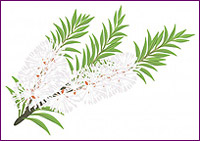Tea Tree Oil
Melaleuca alternifolia

Description
Tea Tree Essential Oil is a must-have oil to keep on hand for a wide array of applications. See the Tea Tree Essential Oil Uses section below for a laundry list of applications for Tea Tree Oil.

The aroma is medicinal, but many become fond (or at the very least, tolerant) to the aroma after becoming accustomed to it. Do consider trying Manuka Essential Oil if you cannot tolerate the aroma of Tea Tree Oil.
Although many authors and educators have expressly stated that Tea Tree Essential Oil can be applied to the skin undiluted, it is prudent to not heed this advice. Less is more. For a detailed explanation, read AromaWeb's Guide to Diluting Essential Oils.
Tea Tree Essential Oil Benefits and Uses
- Acne
- Athlete's Foot
- Candida
- Chicken Pox
- Cold Sores
- Colds
- Corns
- Cuts
- Flu
- Insect Bites
- Itching
- Migraine
- Oily Skin
- Ringworm
- Sinusitis
- Sores
- Spots
- Urethritis
- Warts
- Whooping Cough
Source: Julia Lawless, The Encyclopedia of Essential Oils (Updated Edition) (London: Harper Thorsons, 2014), 189-190.
Botanical Name
Plant Family
Common Method of Extraction
Steam Distilled
Plant Part Typically Used
Color

Clear with a Yellow Tinge
Consistency
Thin
Perfumery Note
Middle
Strength of Initial Aroma
Medium
Aromatic Description
Tea Tree Oil smells medicinal, fresh, woody, earthy and herbaceous.
Major Constituents
- Terpinene-4-ol
- Gamma-Terpinene
- a-Terpinene
- Terpinolene
- 1,8-Cineole
- a-Terpineol
- p-Cymeme
- a-Pinene
See Essential Oil Safety for more complete list of typical constituents.
Source: I. Southwell. Tea Tree Oil Composition, Standards and Monographs. (Cosmetics, Aerosols & Toiletries in Australia 10, 1997), 14-17. Source cited in Robert Tisserand and Rodney Young, Essential Oil Safety (Second Edition. United Kingdom: Churchill Livingstone Elsevier, 2014), 440.
Tea Tree Essential Oil Safety Information
Tisserand and Young indicate that there is a low risk of skin sensitization when using Tea Tree topically. They recommend a dermal maximum of 15% and precaution to avoid use of the oil if it has oxidized. Reading Tisserand and Young's full profile is recommended. [Robert Tisserand and Rodney Young, Essential Oil Safety (Second Edition. United Kingdom: Churchill Livingstone Elsevier, 2014), 440-445.]
General Safety Information
Do not take any oils internally and do not apply undiluted essential oils, absolutes, CO2s or other concentrated essences onto the skin without advanced essential oil knowledge or consultation from a qualified aromatherapy practitioner. For general dilution information, read AromaWeb's Guide to Diluting Essential Oils. If you are pregnant, epileptic, have liver damage, have cancer, or have any other medical problem, use oils only under the proper guidance of a qualified aromatherapy practitioner. Use extreme caution when using oils with children and be sure to first read the recommended dilution ratios for children. Consult a qualified aromatherapy practitioner before using oils with children, the elderly, if you have medical issues or are taking medications. Before using this or any essential oil, carefully read AromaWeb's Essential Oil Safety Information page. For in-depth information on oil safety issues, read Essential Oil Safety by Robert Tisserand and Rodney Young.
Shelf Life
Important Information About the Profiles
The essential oil information provided on AromaWeb is intended for basic educational purposes only. The references to safety information, test results, constituents and percentages is generalized information. Essential oils can vary greatly in composition. The data is not necessary complete and is not guaranteed to be accurate. The essential oil photos are intended to represent the typical and approximate color of each essential oil. However, essential oil composition and color can vary based on harvesting, distillation, age of the essential oil and other factors. Profiles for several CO2 Extracts and absolutes are included within the directory, and are denoted as such.
